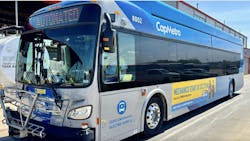CapMetro, WSP debut automated battery-electric bus demonstration
The Capital Metropolitan Transportation Authority (CapMetro) Yard Automation Research and Deployment Program deployed the first SAE Level 4, automated 40-foot battery-electric bus (BEB) in North America.
The retrofitted bus was challenged to maneuver through an active transit depot, brake for unexpected obstacles, and with the precision of a few centimeters, park underneath a charging pantograph dispenser.
The momentous demonstration was held at CapMetro’s North Operations and Maintenance Facility in Austin, Texas. The deployment was led by WSP in the U.S.
“During the demonstration, the bus encountered pedestrians, vehicles and large objects and instantly reacted appropriately to changing situations to complete its assigned route,” said Severin Skolrud, vice president of critical and emerging technology for national transit and rail, WSP U.S. “The most complex maneuver sent the autonomous bus to drive and park underneath an overhead pantograph charging dispenser—within just five to seven centimeters of accuracy—and initiate a charging session, all without anyone behind the steering wheel.”
WSP notes bus yard automation has the potential to significantly reduce costs for zero-emission fleets, significantly increase existing yard capacity and boost safety for drivers, mechanics and others who work in active bus depots.
WSP oversees all project aspects and supports CapMetro as its agency representative for all project stakeholders involved with vehicle infrastructure testing, safety certification and planning. CapMetro’s project partners include Perrone Robotics, Inc., Texas A&M Transportation Institute and Clever Devices.
Perrone Robotics transformed a CapMetro BEB into a fully autonomous vehicle using its TO Navigate You retrofit kit, delivering SAE Level 4 autonomy and advanced yard-optimized autonomous operations software. WSP is evaluating real-world operational benefits, showcasing the future of intelligent, driverless transit.
The $1.26 million project is partly funded by a nearly $950,000 award provided through the Federal Transit Administration’s Advanced Driver Assistance Systems (ADAS) for Transit Buses Demonstration and Automated Transit Bus Maintenance and Yard Operations Demonstration Program.
WSP says early testing has revealed that this technology can increase yard capacity by 80-to-90 percent, creating valuable space to build additional facilities or sell land parcels for additional revenue. Furthermore, the system has the ability to reduce trip time by an average of six-to-eight minutes due to operators not having to walk in the yard, find their vehicle and drive to the security gate after performing their pre-trip inspections, creating further savings for agency operations.
“The demonstration took an idea that’s never been attempted before and turned it into reality,” Skolrud said. “It’s important to focus on the small wins that push the industry and manufacturers to take potential safety and operational benefits seriously and provide ADAS and ADS options to transit customers.”
WSP explains a potential second phase for the program will include three BEBs, deeper integration with the vehicle platform, a multi-year deployment and the development of a new automated dispatch software that can remotely start and pre-condition each of the buses, then direct them on missions such as to safely drive to a designated area closer to the facility for the operator to perform their pre-trip inspection.
